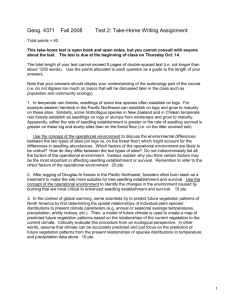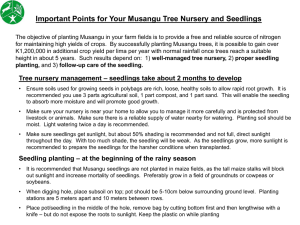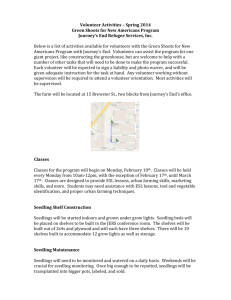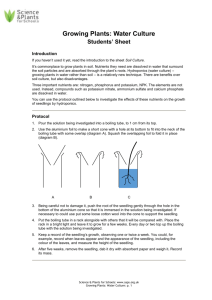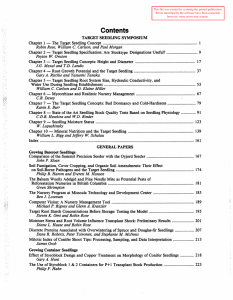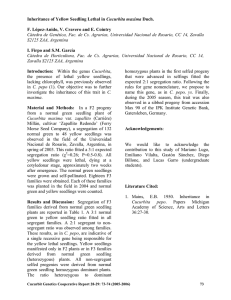Success of Hardwood Tree Plantations in Indiana and Implications for Nursery Managers
advertisement
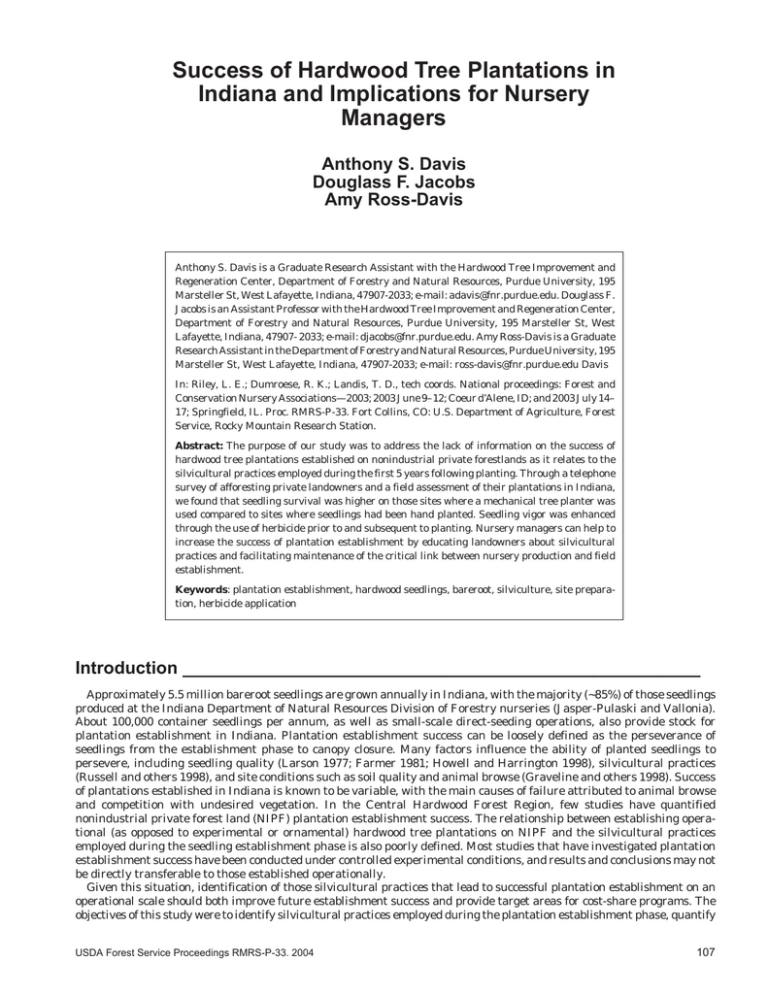
Success of Hardwood Tree Plantations in Indiana and Implications for Nursery Managers Anthony S. Davis Douglass F. Jacobs Amy Ross-Davis Anthony S. Davis is a Graduate Research Assistant with the Hardwood Tree Improvement and Regeneration Center, Department of Forestry and Natural Resources, Purdue University, 195 Marsteller St, West Lafayette, Indiana, 47907-2033; e-mail: adavis@fnr.purdue.edu. Douglass F. Jacobs is an Assistant Professor with the Hardwood Tree Improvement and Regeneration Center, Department of Forestry and Natural Resources, Purdue University, 195 Marsteller St, West Lafayette, Indiana, 47907- 2033; e-mail: djacobs@fnr.purdue.edu. Amy Ross-Davis is a Graduate Research Assistant in the Department of Forestry and Natural Resources, Purdue University, 195 Marsteller St, West Lafayette, Indiana, 47907-2033; e-mail: ross-davis@fnr.purdue.edu Davis In: Riley, L. E.; Dumroese, R. K.; Landis, T. D., tech coords. National proceedings: Forest and Conservation Nursery Associations—2003; 2003 June 9–12; Coeur d’Alene, ID; and 2003 July 14– 17; Springfield, IL. Proc. RMRS-P-33. Fort Collins, CO: U.S. Department of Agriculture, Forest Service, Rocky Mountain Research Station. Abstract: The purpose of our study was to address the lack of information on the success of hardwood tree plantations established on nonindustrial private forestlands as it relates to the silvicultural practices employed during the first 5 years following planting. Through a telephone survey of afforesting private landowners and a field assessment of their plantations in Indiana, we found that seedling survival was higher on those sites where a mechanical tree planter was used compared to sites where seedlings had been hand planted. Seedling vigor was enhanced through the use of herbicide prior to and subsequent to planting. Nursery managers can help to increase the success of plantation establishment by educating landowners about silvicultural practices and facilitating maintenance of the critical link between nursery production and field establishment. Keywords: plantation establishment, hardwood seedlings, bareroot, silviculture, site preparation, herbicide application Introduction _____________________________________________________ Approximately 5.5 million bareroot seedlings are grown annually in Indiana, with the majority (~85%) of those seedlings produced at the Indiana Department of Natural Resources Division of Forestry nurseries (Jasper-Pulaski and Vallonia). About 100,000 container seedlings per annum, as well as small-scale direct-seeding operations, also provide stock for plantation establishment in Indiana. Plantation establishment success can be loosely defined as the perseverance of seedlings from the establishment phase to canopy closure. Many factors influence the ability of planted seedlings to persevere, including seedling quality (Larson 1977; Farmer 1981; Howell and Harrington 1998), silvicultural practices (Russell and others 1998), and site conditions such as soil quality and animal browse (Graveline and others 1998). Success of plantations established in Indiana is known to be variable, with the main causes of failure attributed to animal browse and competition with undesired vegetation. In the Central Hardwood Forest Region, few studies have quantified nonindustrial private forest land (NIPF) plantation establishment success. The relationship between establishing operational (as opposed to experimental or ornamental) hardwood tree plantations on NIPF and the silvicultural practices employed during the seedling establishment phase is also poorly defined. Most studies that have investigated plantation establishment success have been conducted under controlled experimental conditions, and results and conclusions may not be directly transferable to those established operationally. Given this situation, identification of those silvicultural practices that lead to successful plantation establishment on an operational scale should both improve future establishment success and provide target areas for cost-share programs. The objectives of this study were to identify silvicultural practices employed during the plantation establishment phase, quantify USDA Forest Service Proceedings RMRS-P-33. 2004 107 Davis, Jacobs, and Ross-Davis the survival and vigor of planted seedlings, relate plantation success to the silvicultural practices used, and recognize potential implications for nursery managers when dealing with afforesting or reforesting NIPF owners. This paper summarizes some of the results reported in Jacobs and others (forthcoming). Methods ______________________ All orders placed at the state-operated Jasper-Pulaski and Vallonia nurseries between 1997 and 2001 were obtained. The 3 most abundantly sold hardwood species at these nurseries are black walnut (Juglans nigra L.), northern red oak (Quercus rubra L.), and yellow poplar (Liriodendron tulipifera L.). Those records that contained at least 300 of 1 of the 3 aforementioned species were identified. Of those records, 200 seedling buyers were randomly selected. The 200 seedling buyers were then sent a letter announcing our intentions to contact them by telephone regarding their tree planting. When contacted, we asked afforesting landowners questions pertaining to the type of site preparation techniques used, the experience of the individual(s) who had planted the trees (forester or non-forester), the tools used to conduct the planting (hand or mechanical), and the type(s) of subsequent tending employed. Eighty-seven sites were identified as suitable for sampling. At each site, we determined the percentage of seedlings surviving and assessed seedling vigor in 3 ways: 1) the number of leaders; 2) whether or not there was evidence of dieback or loss of the terminal leader; and 3) whether or not the seedling was considered to be free-to-grow. A seedling was classified as free- to-grow if it was at least 1.5 m (5 ft) in height and none of the competing vegetation within a 1.5 m radius was greater than two-thirds of the seedling height. The severity of competing vegetation was also assessed in terms of cover and height of grasses, sedges, and rushes, herbaceous vegetation, and naturally regenerating trees, shrubs, and woody vines. Results and Discussion _________ Success of Hardwood Tree Plantations in Indiana and Implications for... combination of chemical and mechanical practices compared to those sites where either mechanical or no site preparation was employed. Accordingly, Jobidon (1990) found that mechanical site preparation increased the diversity of herbaceous vegetation that recolonized. Height of competing vegetation was also lower on those sites where chemical site preparation was used in conjunction with mechanical site preparation, when compared to the sole use of mechanical site preparation. It is hypothesized that mechanical site preparation allows buried seeds the opportunity to germinate as well as prepares the soil to accept seeds from surrounding sources. Sites that were prepared for planting using either chemical or a combination of chemical and mechanical methods had higher seedling survival than sites where mechanical site preparation was solely used. However, there was no significant difference between site preparation and the absence of site preparation (Figure 1). Site preparation can affect both short(Lockhart and others 2003) and long-term (McGee 1977) plantation performance and should be implemented appropriately wherever possible. Similar to the findings of Russell and others (1998), sites that were planted mechanically (Figure 2) had higher survival than those planted by hand. This may be related to seedling roots being too large for the planting hole, which can cause “J-rooting” and may result in poor seedling growth or seedling mortality. Subsequent herbicide application (Figure 3) plantings established by professional foresters, and those established using mechanical tree planting, resulted in a higher percentage of free-to-grow seedlings. However, those sites that were planted by professional foresters and those that were established with a mechanical planter were also more likely to receive subsequent herbicide applications. Thus, there may be a confounding effect whereby differences associated with planter experience or method of planting are actually related to whether or not herbicide had been applied subsequent to planting rather than the planter’s experience or tool used. Although commonly employed, mowing has not been identified as a substitute for subsequent chemical weed control of hardwood plantations (von Althen 1984). In each of the 5 years examined, approximately 65% of planted seedlings survived. We found it interesting that there was no additive mortality across the 5 years. There was also little variation in seedling vigor across the 5 years. Dieback or loss of the terminal leader was present on approximately 83% of all seedlings, while about 25% of seedlings had 3 or more leaders. The percentage of seedlings that were free-to-grow ranged from less than 3% in year 1 to almost 50% in year 5. Further examination of the 6 most commonly planted species at year 5 revealed that approximately 80% of black cherry (Prunus serotina Ehrh.), 70% of white ash (Fraxinus americana L.), 65% of yellow poplar, 50% of white oak (Quercus alba L.), 40% of black walnut, and 30% of northern red oak seedlings were free-togrow. The relatively low percentage of black walnut seedlings that were free-to-grow at year 5 was attributed to a number of apparent species-by-site mismatches. Competing herbaceous cover was lower on sites prepared by a 108 Seedling survival (%) Plantation Establishment Success 100 90 80 70 60 50 40 30 20 10 0 b b ab a Mechanical Chemical Mechanical and chemical No site preparation Site preparation method Figure 1—Percentage of seedlings surviving for each site preparation method. Different letters identify significant differences among treatments at a = 0.10. USDA Forest Service Proceedings RMRS-P-33. 2004 Success of Hardwood Tree Plantations in Indiana and Implications for... Figure 2—Mechanical planting. Figure 3—Evidence of subsequent herbicide application in a hardwood plantation established on former pastureland. Implications for Nursery Managers Nursery managers have extensive knowledge of the requirements of caring for and growing seedlings and have the USDA Forest Service Proceedings RMRS-P-33. 2004 Davis, Jacobs, and Ross-Davis unique opportunity to deal with seedling buyers prior to planting. They are also able to direct seedling buyers to extension agents, government personnel, or consulting foresters who understand the diverse objectives of landowners. This dissemination of information is pivotal to ensure the long-term success of the planting. Given that estimates on a national scale indicate that only about 10% of NIPF owners use available technical forest management assistance (Mangold 1994), nursery managers should be prepared to assist seedling buyers. To improve the likelihood of successful establishment, it would be beneficial to remind seedling buyers to match the species they are purchasing to the ecological characteristics of the site they intend to plant. Many nurseries have this information available, and ensuring its availability to seedling buyers should lead to improved seedling survival and vigor. Working with a professional forester to establish the plantation in an appropriate manner (that is, proper site preparation and planting with a mechanical tree planter) should also improve plantation establishment. Nursery managers should maintain an upto-date list of consulting foresters that may assist in plantation establishment, which could be distributed to seedling buyers. Those who choose not to work with a professional forester could be given extension publications that describe important steps in plantation establishment, such as seedling grading and storage, method of planting, and stand maintenance. The results of this study should also allow nursery managers to reaffirm to afforesting and reforesting landowners that following the recommended stand tending schedule, especially with regard to subsequent herbicide application, will result in development of a stand of trees that becomes free-to-grow at an earlier age. The target seedling concept states that a quality seedling is one that will thrive upon outplanting (Landis 2003). There is no set standard that can be applied to all species and all sites to ensure success. For a nursery to produce seedlings that will perform as desired upon outplanting, communication between the seedling buyer and the nursery is critical. Identification of what has led to success or failure under specific conditions can help produce better results in the future. Nursery managers can work in conjunction with seedling users to develop standards that generally perform well under a given set of field conditions. Control of nursery cultural practices to meet desired standards of seedling morphological and physiological characteristics can produce a target seedling for a specific tree planting scenario (Rose and others 1990). Ongoing interactions between those who engage in tree planting and nursery managers will hopefully lead to higher outplanting survival. As evidenced by the high mortality rate of seedlings planted on private lands in Indiana, implementation of this practice could lead to a meaningful increase in survival. Future Directions and Concluding Remarks ______________________ Much more information is needed to understand the state of tree planting success on NIPFs. Future research into bottomland plantations, the relationship between seedling establishment and the number and timing of subsequent herbicide applications, and inclusion of stock produced in 109 Davis, Jacobs, and Ross-Davis privately operated nurseries would be beneficial in terms of providing a more complete picture of operational plantation establishment success. Furthermore, our approach should be extrapolated to include plantations established with containerized stock and by direct-seeding. While these methods are currently small in scale compared to plantations established with bareroot seedlings, they may increase in significance in the future. As such, it is important to understand the differences and similarities between these types of stock and their requirements for successful plantation establishment. Increasing the breadth of scope to include seedling handling and storage practices and different tending practices, including fertilization, irrigation, and pruning, will lead to better understanding of how to successfully establish plantations in the Central Hardwood Forest Region. Several silvicultural practices were found to increase plantation establishment success, presently identified to be around 65%. There was a wide range in survival, from near perfect to complete failures. Investigation into the causes of mortality during the first year of seedling establishment is necessary to provide a full understanding of the practices required to successfully establish a stand on an operational level. By increasing the number of landowners who engage in the requisite steps identified, plantation establishment success should be improved. Directing landowners who recently established plantations to cost-share opportunities specifically designed for subsequent stand tending will likely lead to increased participation in those activities identified as key to success. This study should add clarity to the issue of the importance of appropriate stand management techniques, particularly those which people may be reluctant to employ, such as herbicide application. Given that future demands placed on private forests are sure to increase, effective plantation management presently will help meet those future needs. Acknowledgments _____________ This study was funded by a Forest Stewardship Challenge Grant from the Indiana Department of Natural Resources (IDNR) and Purdue University. Assistance in the design of the study was provided by Dan Ernst (IDNR), Ron Overton (USDA FS), and John Seifert (Purdue University). We would like to thank Jim Wichman and the staff of the Indiana DNR Vallonia nursery for their assistance in 110 Success of Hardwood Tree Plantations in Indiana and Implications for... providing us with all nursery orders, those consulting foresters who supplied us with planting plans, and all of the landowners who participated in the survey and allowed us to sample their plantations. References ____________________ Farmer RE, Jr. 1981. Early growth of black cherry, oaks, and yellowpoplar in southern Appalachian plantings. Tree Planters’ Notes 32:12-14. Graveline BD, Wells GR, Schlarbaum SE, Fribourg HA. 1998. Growth and protection of selected northern red oak seedlings planted on old field sites. In: Waltrop TA, editor. Proceedings of the ninth biennial southern silvicultural research conference. Asheville (SC): USDA Forest Service, Southern Research Station. General Technical Report SRS-20. p 257-262. Howell KD and Harrington TB. 1998. Regeneration efficiency of bareroot oak seedlings subjected to various nursery and planting treatments. In: Waltrop TA, editor. Proceedings of the ninth biennial southern silvicultural research conference. Asheville (SC): USDA Forest Service, Southern Research Station. General Technical Report SRS-20. p 222-226. Jacobs DF, Ross-Davis AL, Davis AS. Establishment success of conservation tree plantations in relation to silvicultural practices in Indiana, USA. New Forests. Forthcoming. Jobidon R. 1990. Short-term effect of three mechanical site preparation methods on species diversity. Tree Planters’ Notes 41:39-42. Landis TD. 2003. The target seedling concept—a tool for better communication between nurseries and their customers. In: Riley LE, Dumroese RK, Landis TD, technical coordinators. National proceedings: forest and conservation nursery—Ogden (UT): USDA Forest Service, Rocky Mountain Research Station. Proceedings RMRS-P-28. p 12-16. Larson MM. 1977. Growth of outplanted northern red oak nursery stock related to shoot characteristics in the seed bed. Tree Planters’ Notes 28:21-23. Lockhart BR, Keeland B, McCoy J and Dean TJ. 2003. Comparing regeneration techniques for afforesting previously farmed bottomland hardwood sites in the Lower Mississippi Alluvial Valley, USA. Forestry 76:169-180. Mangold R. 1994. Comments: Reforestation technical assistance for the non-industrial private forestland owner—opportunity knocks. Tree Planters’ Notes 45:1-2. McGee CE. 1977. Planted yellow-poplar grows well after essential site preparation. Tree Planters’ Notes 28:5-7, 38. Russell DR, Jr., Hodges JD, Ezell AW. 1998. An evaluation of hardwood reforestation methods on previously farmed lands in central Alabama. In: Waltrop TA, editor. Proceedings of the ninth biennial southern silvicultural research conference. Asheville (SC): USDA Forest Service, Southern Research Station. General Technical Report SRS-20. p 272-276. von Althen FW. 1984. Mowing versus mechanical or chemical weed control in sugar maple afforestation. Tree Planters’ Notes 35:28-31. USDA Forest Service Proceedings RMRS-P-33. 2004
